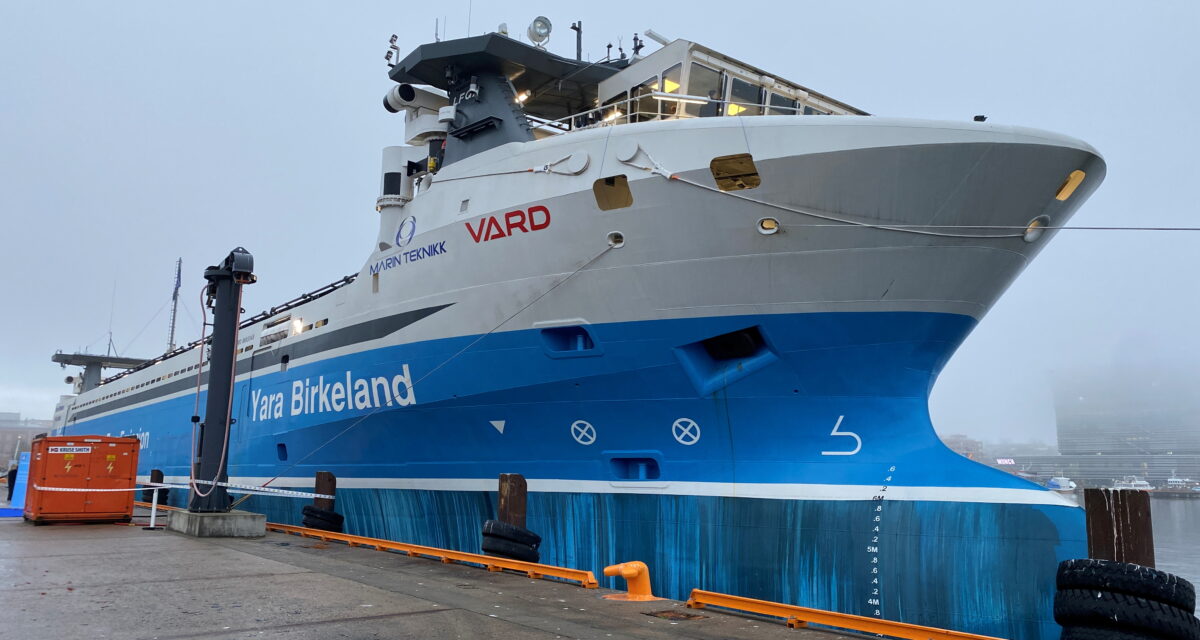Circular
Servirio`s News
NORWAY UNVEILS WORLD’S FIRST ELECTRICALLY POWERED AND AUTONOMOUS CARGO SHIP

Zero emissions and, shortly, zero crew. Norway has launched the world’s first 100% electric and autonomous freighter, an important technological progress and a small ecological contribution to a sector that seeks to reduce its environmental impact.
The “Yara Birkeland”, presented to the press this Friday, will be in charge of the maritime transport of up to 120 containers of fertilizer from a factory in Porsgrunn (southeast) to the port of Brevik, a dozen kilometers away, thereby will avoid annually about 40,000 pollutants traveled by truck.
“Of course, there were difficulties, setbacks, so it is more gratifying, if possible, to be able to be here today and see that we have achieved it,” Yara CEO Sveint Tore Holsether told AFP in front of the elongated white boat. and blue, moored to a pier in Oslo.
Many months late, the 80-meter long, 3,200-tonne deadweight “Yara Birkeland” will begin a two-year test campaign that will help it operate with fewer and fewer crew members.
The command bridge should disappear within “three, four or five years”, according to Holsether, with which it is expected that the ship can travel its daily journey of 7.5 nautical miles by its own means thanks to sensors.
“Many of the incidents that occur on ships are due to human errors, fatigue, for example,” explained project manager Jostein Braaten from the short-lived command post.
“Autonomous operations can guarantee safe travel,” he said.
Although the distance traveled is short, the obstacles are not few: the “Yara Birkeland” will have to navigate through a narrow fjord, pass under two bridges dealing with the current and share the route with commercial boats, pleasure boats and kayaks before docking. in one of the most saturated ports in Norway.
The next few months will be dedicated to learning.
“First, we have to detect that there is something, understand that it is a kayak, and then determine what to do,” said Jostein Braaten.
“Today the big ships hardly care about the kayaks, they can’t. They can signal, but they can’t maneuver or reverse to avoid an incident,” he explained.
In addition, autonomy also requires the implementation of a regulation that does not even exist.
– “Hundred Tesla” –
On board the “Yara Birkeland”, the traditional engine room has been replaced by eight compartments filled with batteries that give the ship a capacity of 6.8 MWh.
“The equivalent of one hundred Tesla,” according to Jostein Braaten.
The maritime sector, responsible for almost 3% of all human-caused greenhouse gas emissions, aims to reduce its emissions by 40% by 2030 and by 50% by 2050.
Among all activities (international, domestic, fishing), their emissions have increased, according to the latest figures available from the International Maritime Organization (IMO), from 962 million tons of greenhouse gases in 2012 to more than 1,000 million tons. tons in 2018.
The “Yara Birkeland” will save the atmosphere 678 tons of CO2 per year, but that contribution is still negligible to combat climate change. In addition, according to experts, this type of transport cannot be generalized.
Thus, electricity as a source of energy can only be applied to some types of boats, such as “ferries, since they are fairly short and stable routes” or “eventually, for cabotage and river transport, but it is poorly adapted to long ocean voyages, “said Camille Egloff, a shipping specialist at the Boston Consulting Group.
“Not only is autonomy needed to cover a significant distance, but port terminals must also be equipped with adapted charging stations. Therefore, there is a challenge not only in technology, but also in charging infrastructures that require coordination of many parties. “, he stressed.
Currently, dozens of electric ferries cross the fjords of Norway, a country that, despite being a large producer of hydrocarbons, is a leader in the electric transport sector.
On the other hand, transoceanic vessels will have to opt for other technological solutions (LNG, e-methanol, hydrogen, ammonia …) to be “greener”.


